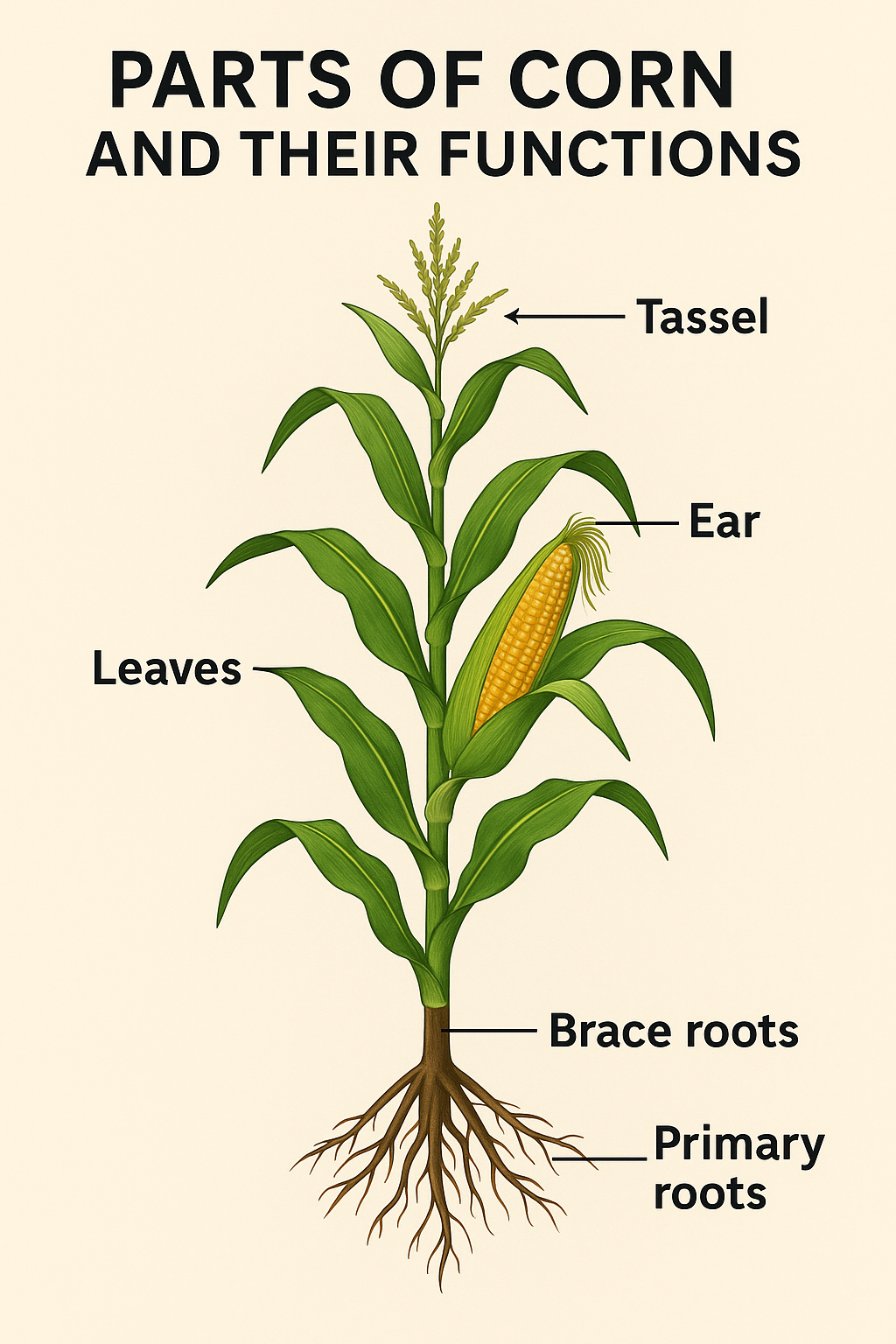Corn (Zea mays L.), also known as maize, is one of the most important cereal crops worldwide. It is grown in tropical, subtropical, and temperate regions for food, feed, fuel, and industrial products. In Pakistan, it holds a major place in both Autumn (June, July, August) and spring ( Jan, Feb and March) seasons, especially in Punjab and Khyber Pakhtunkhwa.
Corn’s versatility lies in its structure. Each part of the plant — from roots to tassels — plays a critical role in its productivity and resilience.
Botanical Classification
- Kingdom: Plantae
- Family: Poaceae
- Genus: Zea
- Species: Zea mays
- Common Name: Corn or Maize
Parts and Their Functions
Corn is a monocotyledonous plant, which means it has a fibrous root system and parallel-veined leaves. Below is a breakdown of its key parts and their specific roles:
1. Roots
🔹 Types:
- Primary root (Radicle) – develops from seed
- Seminal roots – early anchorage and absorption
- Nodal roots – develop from stem nodes
- Brace roots – aerial roots for support
🔸 Function:
- Anchor the plant in soil
- Absorb water and nutrients
- Help in nutrient transport to upper parts
- Brace roots prevent lodging in storms
2. Stem (Stalk)
- Composed of nodes and internodes
- Hollow or filled pith depending on variety
🔸 Function:
- Supports the plant structure
- Transports water, nutrients, and sugars
- Storage of carbohydrates
- Provides strength for cob support
3. Leaves
- Arranged alternately
- Each leaf has a blade, sheath, and ligule
🔸 Function:
- Perform photosynthesis
- Regulate transpiration through stomata
- Aid in light capture and energy production
4. Tassel (Male Flower)
- Located at the top of the plant
- Produces pollen
🔸 Function:
- Releases millions of pollen grains for fertilization
- Begins flowering process at reproductive stage
5. Ear or Cob (Female Flower)
- Grows from leaf axil (mid-plant)
- Contains silks, kernels, and husk leaves
🔸 Function:
- Site of seed (kernel) development
- Receives pollen through silks
- Husk protects developing kernels
6. Silks
- Elongated styles emerging from kernels
🔸 Function:
- Each silk connects to one kernel
- Capture pollen and transmit it to ovary for fertilization
7. Kernels (Seeds)
- The actual grain harvested
- Each kernel has endosperm, germ, and pericarp
🔸 Function:
- Reproduction and propagation
- Source of food (carbohydrates, oil, protein)
- Industrial use for ethanol, starch, and oils
Important Growth Stages
Understanding corn’s development is critical for timely fertilizer, pest control, and irrigation management.
| Stage | Name | Description |
|---|---|---|
| VE | Emergence | Seedling breaks through soil |
| V3–V9 | Vegetative stages | Leaf development; roots expand |
| VT | Tasseling | Tassel fully visible; pollen release begins |
| R1 | Silking | Silks appear; pollination occurs |
| R2 | Blister | Kernels form a watery blister |
| R3 | Milk | Kernels contain milky fluid |
| R4 | Dough | Kernels thicken; starch accumulates |
| R5 | Dent | Kernels dented; nearing maturity |
| R6 | Physiological Maturity | Maximum dry weight reached |
Importance of Corn in Agriculture
For Food:
- Cornmeal, flour, and sweet corn are dietary staples.
- Used in snacks, cereals, and baked goods.
For Fodder:
- Green maize and silage are excellent cattle feed.
- Residues like husk and cobs are used in bedding and feed.
For Industry:
- Corn starch, oil, and syrup have industrial applications.
- Bioethanol is a renewable fuel source from maize.
For Economy:
- Export potential for corn and derivatives.
- Job creation in seed, farming, and processing sectors.
Production in Pakistan
Corn is grown across Punjab, Khyber Pakhtunkhwa, and Sindh under both irrigated and rainfed conditions. High-yielding hybrids like Dekalb spring Hybrids ( DK 6321, DK 6317 and DK 7024) Autumn Hybrids (DK 8222, DK 8148 and DK 8022), National Organization Sohni Dharti ( SD 3555, SD 3575) Autumn Portfolio ( SD 62s55, SD 828, SD 626 and SD 36S46) Corteva Agri Sciences Pakistan Spring Portfolio (P 1429 and Shahkar) Autumn Portfolio (P 3875 and P4040) dominate the market.
Improved seed quality, balanced fertilization, and pest management are key to improving productivity.
